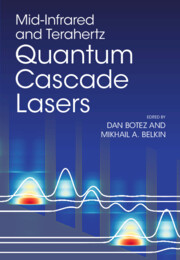Book contents
- Frontmatter
- Dedication
- Contents
- Preface
- Part I Bandstructure Engineering, Modeling and State-of-the-Art QCLs
- 1 Basic Physics of Intersubband Radiative and Nonradiative Processes
- 2 State-of-the-Art Mid-Infrared QCLs: Elastic Scattering, High CW Power, and Coherent-Power Scaling
- 3 Long-Wavelength Mid-Infrared Quantum Cascade Lasers
- 4 Overview of the State-of-the-Art Terahertz QCL Designs
- 5 Simulating Quantum Cascade Lasers: The Challenge to Quantum Theory
- 6 Coupled Simulation of Quantum Electronic Transport and Thermal Transport in Mid-Infrared Quantum Cascade Lasers
- Part II Active Research Topics
- Part III Applications
- Index
2 - State-of-the-Art Mid-Infrared QCLs: Elastic Scattering, High CW Power, and Coherent-Power Scaling
from Part I - Bandstructure Engineering, Modeling and State-of-the-Art QCLs
Published online by Cambridge University Press: 25 August 2023
- Frontmatter
- Dedication
- Contents
- Preface
- Part I Bandstructure Engineering, Modeling and State-of-the-Art QCLs
- 1 Basic Physics of Intersubband Radiative and Nonradiative Processes
- 2 State-of-the-Art Mid-Infrared QCLs: Elastic Scattering, High CW Power, and Coherent-Power Scaling
- 3 Long-Wavelength Mid-Infrared Quantum Cascade Lasers
- 4 Overview of the State-of-the-Art Terahertz QCL Designs
- 5 Simulating Quantum Cascade Lasers: The Challenge to Quantum Theory
- 6 Coupled Simulation of Quantum Electronic Transport and Thermal Transport in Mid-Infrared Quantum Cascade Lasers
- Part II Active Research Topics
- Part III Applications
- Index
Summary
Quantum cascade lasers (QCLs) emitting in the 4-10 micron wavelength range are treated with emphasis on key issues not covered in previous books on QCLs. The foremost issue discussed: what does it take to achieve continuous-wave (CW) operation to multi-watt powers in a highly efficient manner, is of interest to a wide range of applications. A comprehensive review of the temperature dependence of the electro-optical characteristics of QCLs is presented by including elastic scattering and carrier-leakage triggered by elastic and inelastic scattering, thus accounting for all mechanisms behind the device internal efficiency. Maximizing the CW wall-plug efficiency via conduction-band and elastic-scattering engineering, and photon-induced carrier transport is treated in detail. Then coherent-power scaling is discussed for both one- and two-dimensional (2-D) structures with emphasis on the optimal solution: high-index-contrast (HC) photonic-crystal (PC) lasers. Grating-coupled surface-emitting lasers are also treated with emphasis on those needed for 2-D HC-PC lasers; that is, devices most likely to operate in diffraction-limited, single-lobe beam pattern to multi-watt CW output powers
Keywords
Information
- Type
- Chapter
- Information
- Mid-Infrared and Terahertz Quantum Cascade Lasers , pp. 41 - 101Publisher: Cambridge University PressPrint publication year: 2023
Accessibility standard: Unknown
Why this information is here
This section outlines the accessibility features of this content - including support for screen readers, full keyboard navigation and high-contrast display options. This may not be relevant for you.Accessibility Information
- 7
- Cited by
